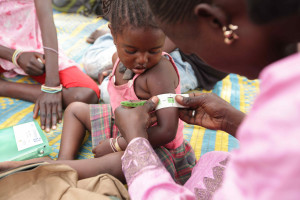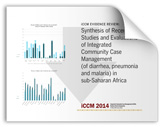2014
Evidence Summit On Community Health Worker and iCCM Efforts
by Phyllis Heydt and Claire Qureshi
An important first-time gathering seeks to understand best practices and approaches to implementing integrated community-based management of childhood diseases.

Community Health Worker in Action
Community Health Workers (CHWs) are essential components of the health systems of many countries, providing care to hundreds of thousands and focusing especially on children at risk of dying from pneumonia, malaria, diarrhea and other diseases. How CHWs operate, how they are supervised and how they are compensated varies widely, within and between countries.
The MDG Health Alliance team – led by Phyllis Heydt and Claire Qureshi – participated in an important Evidence Symposium bringing together global experts on CHWs and Integrated Community Case Management (iCCM), the official acronym for the practice combining health delivery at the community level with an integrated set of malaria, pneumonia and diarrhea services to improve child survival. The purpose of the meeting was to identify best practices and key challenges in the implementation of integrated, community-based case management of childhood illnesses. UNICEF, with support from Canada’s Department of Foreign Affairs, Trade, and Development (DFATD) and the Bill & Melinda Gates Foundation, convened experts and country teams to review the existing evidence on iCCM and to discuss how to strengthen country programs.
When 400 people from 35 countries convene, consensus is rarely the outcome, but the symposium provided important insights into high-performing models and best practices that will be useful for ministries, program implementers, and donors.
The conference included thematic sessions on topics such as supply chain management, supervision of CHWs, and health information systems as well as in-depth country discussions during which teams discussed the status of iCCM programs in their countries and explored next steps informed by the thematic presentations.
The Challenge of Low Utilization
UNICEF, Save the Children, and Johns Hopkins University took the lead in summarizing themes and conclusions, drawing on their years of experience working on community-based management of childhood illness and the experience of additional partners. One overarching theme was the need to use demand creation strategies such as media campaigns and interpersonal communication to increase how often patients use services provided by CHWs. Diarrhea, pneumonia, and malaria treatment practices are known to be effective, but because of poor uptake, they achieved lower-than-expected impact in many of the programs the researchers assessed.
The team was able to identify a set of levers that are linked with programs that saw a strong uptake of iCCM services. These levers include: a high degree of supervision of community health workers; reliable availability of key commodities; diagnostic and treatment services at no charge; insuring that health workers are able to address and treat all three illnesses (malaria, pneumonia and diarrhea) as opposed to only one or two of these; and commitment to program implementation at proper scale for a duration of at least one year. As communities increase their utilization of iCCM services, cost per treatment declines and cost-effectiveness rises. Another important conclusion showed that there is no single proven model of human resource management for community-based interventions: programs that pay CHWs or use volunteers can both work, and the impact depends on context and support available through NGO partners.
 Download a copy of the evidence review
Download a copy of the evidence review
Recommendations for CHW Donors and Planners
The symposium leaders attempted a meta-analysis on mortality reduction as a result of iCCM utilization, but given the difficulty comparing data across studies from ten country data sets, no clear conclusions were possible. Several key recommendations emerged from the symposium, however, including:
- Importance of integrating all community-delivered services – malaria, pneumonia and diarrhea, along with nutrition, family planning, newborn services – and establishing stronger links between community health services and care at the facility level
- Ensuring that national malaria control and family health programs partner in their strategic planning process, in mobilization of resources, and in program implementation and monitoring of progress
- Using greater advocacy to secure senior level buy-in for iCCM investment at a country level
- Ensuring that iCCM decisions and program designs are based on stronger data systems
- Getting ministries of health to take the lead in developing one national approach to iCCM and then, working with their key partners to implement the approach and bring to scale
Ethiopia, which has already achieved its MDG4 target (child survival) – in great part because of its embrace of iCCM – shared its thoughts on key ingredients for success. Dr. Kesete-birhan Admasu, the honorable Minister of Health from Ethiopia, underscored the importance of governments having the political will to build iCCM programs, given that iCCM works best when there is a strong community platform, and programs can be scaled quickly.
More information on the symposium, as well as the presentations made can be found at: http://1010iccmsymposium.org/

